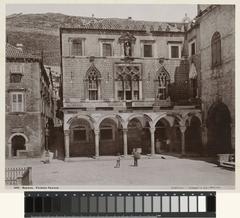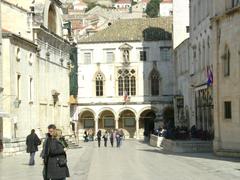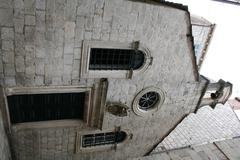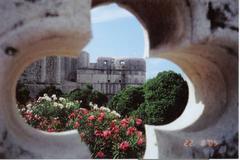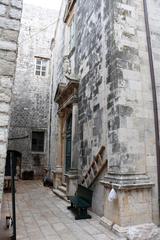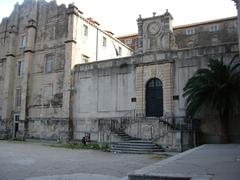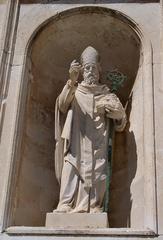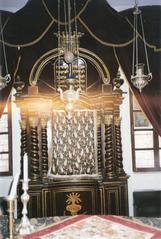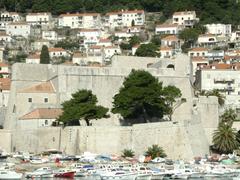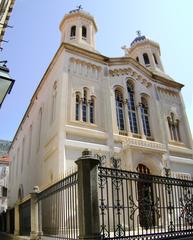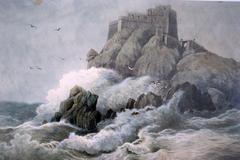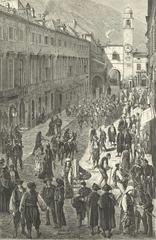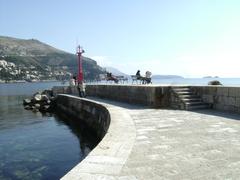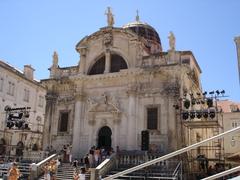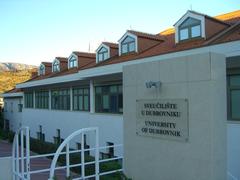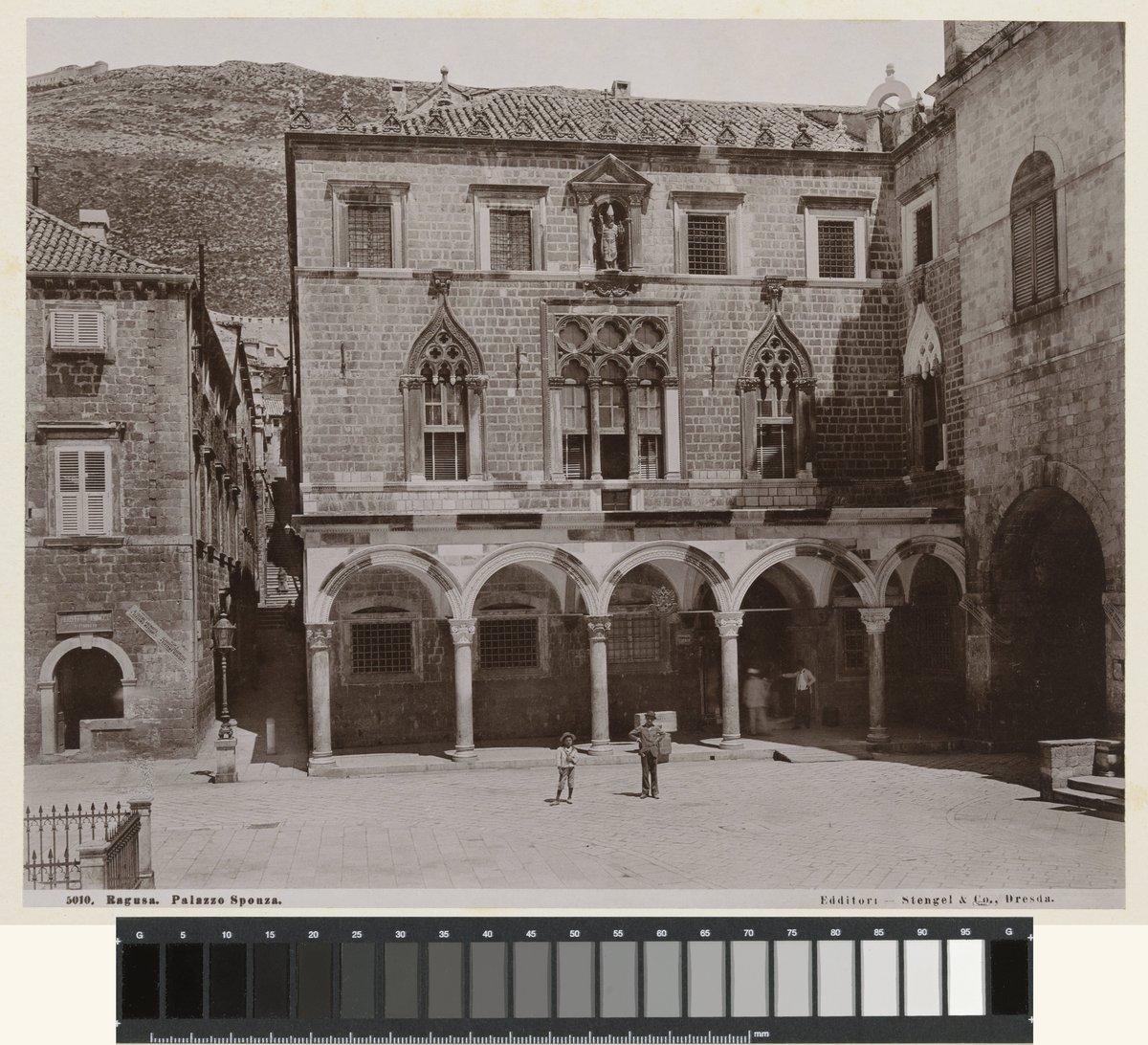
Palača Sponza Visiting Hours, Tickets, and Historical Significance
Date: 22/07/2024
Introduction
Palača Sponza, also known as the Sponza Palace, stands as one of Dubrovnik’s most iconic and historically significant structures. Built between 1516 and 1522, this magnificent edifice is a testament to the architectural ingenuity of the Renaissance period, with a harmonious blend of Gothic and Renaissance styles (Dubrovnik Heritage). Originally serving as the customs office, mint, and treasury of the Republic of Ragusa, Palača Sponza played a critical role in the economic and civic life of Dubrovnik (Croatia Tourism). Today, it functions as a museum and cultural center, housing the Dubrovnik State Archives and hosting various exhibitions and events. This comprehensive guide aims to provide potential visitors with detailed information on the history, architectural significance, visitor logistics, and travel tips, ensuring a memorable experience at one of Dubrovnik’s historic gems.
Table of Contents
- Introduction
- Origins and Construction of Palača Sponza
- Multifunctional Purpose
- Cultural and Civic Significance
- Visitor Information
- Preservation and Restoration
- Modern-Day Use
- FAQ
- Conclusion
A Guide to Visiting Palača Sponza - History, Tickets, and More
Introduction
Palača Sponza, also known as the Sponza Palace, is one of the most significant historical buildings in Dubrovnik, Croatia. This comprehensive guide will cover the origins, construction, and visitor information for Palača Sponza, making your visit to this magnificent site a memorable experience.
Origins and Construction of Palača Sponza
Historical Context
Palača Sponza dates back to the early 16th century, a period marked by the flourishing of the Republic of Ragusa, the maritime republic centered in Dubrovnik. The palace was constructed between 1516 and 1522, during a time when Dubrovnik was a major hub of trade and commerce in the Adriatic Sea. The Republic of Ragusa was known for its sophisticated governance and economic prowess, which is reflected in the architectural grandeur of Palača Sponza.
Architectural Design and Style
The design of Palača Sponza is a testament to the architectural ingenuity of the Renaissance period. The palace was designed by the architect Paskoje Miličević, who was a prominent figure in Dubrovnik’s architectural scene. The structure is a harmonious blend of Gothic and Renaissance styles, which was a common architectural trend in Dubrovnik during the early 16th century. The Gothic elements are evident in the pointed arches and intricate stone carvings, while the Renaissance influence is seen in the symmetry and proportion of the building.
The palace’s façade is adorned with a series of elegant arches and columns, creating a visually striking appearance. The central courtyard, known as the atrium, is surrounded by arcades on all four sides, providing a serene and open space within the building. The atrium was designed to serve as a public space for various civic activities, reflecting the building’s multifunctional purpose.
Construction Materials and Techniques
The construction of Palača Sponza utilized locally sourced materials, primarily limestone from the nearby island of Korčula. This high-quality stone was known for its durability and aesthetic appeal, making it a popular choice for many of Dubrovnik’s historic buildings. The use of limestone also contributed to the uniform appearance of the city’s architecture, creating a cohesive and visually pleasing urban landscape.
The construction techniques employed in building Palača Sponza were advanced for their time. The masons and craftsmen who worked on the palace were highly skilled, and their expertise is evident in the precision and detail of the stonework. The building’s structural integrity has been maintained over the centuries, a testament to the quality of the construction methods used.
Multifunctional Purpose
Palača Sponza was designed to serve multiple functions, reflecting the diverse needs of the Republic of Ragusa. Initially, the palace housed the customs office, where goods entering and leaving the city were inspected and taxed. This function was crucial for the economic prosperity of Dubrovnik, as trade was the lifeblood of the republic.
In addition to its role as a customs office, Palača Sponza also served as a mint, where the city’s currency was produced. The palace housed a state treasury, which safeguarded the republic’s wealth and financial records. The building’s multifunctional design is a reflection of the pragmatic and efficient governance of the Republic of Ragusa.
Cultural and Civic Significance
Palača Sponza was not only a center of economic activity but also a hub of cultural and civic life in Dubrovnik. The palace hosted various public events, including meetings of the city’s council and gatherings of prominent citizens. The atrium, with its open and inviting design, was a popular venue for social and cultural activities.
One of the most notable features of Palača Sponza is the inscription on its façade, which reads - “Fallere nostra vetant; et falli pondera. Meque pondero cum merces ponderat ipse deus.” This Latin inscription translates to “Our weights do not permit cheating. When I measure goods, God measures with me.” This inscription reflects the values of honesty and integrity that were central to the governance of the Republic of Ragusa.
Visitor Information
Visiting Hours
Palača Sponza is open to visitors from 8 AM to 8 PM daily. However, it is advisable to check the official [Dubrovnik tourism website](https - //www.tzdubrovnik.hr/lang/en/get/dubrovnik/) for any changes in opening hours or special events that might affect visitor access.
Tickets and Guided Tours
Tickets for Palača Sponza can be purchased at the entrance or online through the official website. General admission is €10 for adults and €5 for children and students. Guided tours are available for an additional fee, offering in-depth insights into the palace’s history and architecture.
Travel Tips
- Accessibility - Palača Sponza is wheelchair accessible, with ramps and elevators available for visitors with mobility issues.
- Nearby Attractions - While visiting Palača Sponza, be sure to explore other nearby historical sites such as the Dubrovnik Cathedral and Rector’s Palace.
- Best Time to Visit - Early mornings or late afternoons are ideal for visiting to avoid the large crowds and enjoy a more serene experience.
- Photography - The central atrium and the façade are excellent spots for photography. Ensure to capture the intricate stone carvings and elegant arches.
Preservation and Restoration
Over the centuries, Palača Sponza has undergone various preservation and restoration efforts to maintain its historical and architectural integrity. The building has survived numerous earthquakes, including the devastating earthquake of 1667, which caused significant damage to many of Dubrovnik’s structures. Despite these challenges, Palača Sponza has remained remarkably well-preserved, thanks to the efforts of conservationists and the local community.
In recent years, the palace has been meticulously restored to its original splendor, ensuring that future generations can appreciate its historical and architectural significance. The restoration efforts have focused on preserving the building’s original features while incorporating modern techniques to enhance its structural stability.
Modern-Day Use
Today, Palača Sponza serves as a museum and cultural center, attracting visitors from around the world. The palace houses the Dubrovnik State Archives, which contains a vast collection of historical documents and records dating back to the 12th century. These archives provide valuable insights into the history and governance of the Republic of Ragusa.
Visitors to Palača Sponza can explore its beautifully preserved rooms and courtyards, gaining a deeper understanding of Dubrovnik’s rich cultural heritage. The palace also hosts various exhibitions and cultural events, making it a vibrant and dynamic part of the city’s cultural landscape.
FAQ
- What are the visiting hours for Palača Sponza?
- The palace is open daily from 8 AM to 8 PM.
- How much are the tickets to Palača Sponza?
- General admission is €10 for adults and €5 for children and students.
- Is Palača Sponza wheelchair accessible?
- Yes, the palace is wheelchair accessible.
- Are guided tours available?
- Yes, guided tours are available for an additional fee.
Conclusion
By understanding the origins and construction of Palača Sponza, visitors can gain a greater appreciation for its historical and cultural significance. This guide provides all the necessary information for a memorable visit to one of Dubrovnik’s most iconic historical sites. For more information, you can visit the [official Dubrovnik tourism website](https - //www.tzdubrovnik.hr/lang/en/get/dubrovnik/).
Call to Action
Stay up to date with the latest events and exhibitions at Palača Sponza by following us on social media or downloading our mobile app. Don’t miss out on exploring more historical sites in Dubrovnik and making the most of your visit.
Exploring Palača Sponza - Historical Significance, Visiting Hours, and Tickets in Dubrovnik
Architectural Origins and Evolution
Palača Sponza, also known as the Sponza Palace, is a remarkable example of Dubrovnik’s architectural heritage, blending Gothic and Renaissance styles. Constructed between 1516 and 1522, the palace was designed by the architect Paskoje Miličević Mihov, who was instrumental in shaping the city’s architectural landscape during the Renaissance period. The palace’s design reflects the transition from Gothic to Renaissance architecture, characterized by its elegant loggia, intricate stone carvings, and harmonious proportions ([Dubrovnik Heritage](https - //www.dubrovnik-heritage.com)).
Multifunctional Role in Dubrovnik’s History
Throughout its history, Palača Sponza has served multiple purposes, reflecting its central role in the civic and commercial life of Dubrovnik. Initially, it functioned as a customs house, where goods were inspected and taxed before entering the city. This role was crucial in maintaining Dubrovnik’s status as a major trading hub in the Adriatic Sea. The palace also housed the mint, treasury, and armory, underscoring its importance in the economic and defensive infrastructure of the city ([Croatia Tourism](https - //www.croatia-tourism.com)).
Cultural and Educational Hub
In addition to its economic functions, Palača Sponza played a significant role in the cultural and intellectual life of Dubrovnik. The palace housed the city’s first public school, established in the 16th century, which contributed to the education of Dubrovnik’s youth and the promotion of literacy and learning. The palace also served as a meeting place for the city’s scholars and intellectuals, fostering a vibrant cultural scene that was instrumental in the development of Dubrovnik’s literary and artistic traditions ([Dubrovnik Museums](https - //www.dubrovnikmuseums.hr)).
The Role During the Dubrovnik Republic
During the period of the Dubrovnik Republic (1358-1808), Palača Sponza was a symbol of the city’s independence and prosperity. The palace’s strategic location at the intersection of the main street, Stradun, and the city’s harbor made it a focal point for trade and diplomacy. The Republic’s officials used the palace for various administrative functions, including the regulation of trade, the collection of taxes, and the administration of justice. The palace’s loggia, with its open arcade, served as a venue for public announcements and gatherings, reinforcing its role as a center of civic life ([UNESCO](https - //whc.unesco.org/en/list/95)).
Preservation and Restoration Efforts
Over the centuries, Palača Sponza has undergone several restoration efforts to preserve its architectural integrity and historical significance. The most notable restoration took place in the 19th century, following the devastating earthquake of 1667, which caused significant damage to the palace and other historic buildings in Dubrovnik. The restoration efforts aimed to restore the palace’s original architectural features while incorporating modern structural reinforcements to ensure its longevity. Today, Palača Sponza stands as a testament to the city’s resilience and commitment to preserving its cultural heritage ([Dubrovnik Times](https - //www.thedubrovniktimes.com)).
The Memorial Room of the Defenders of Dubrovnik
One of the most poignant aspects of Palača Sponza’s historical significance is its role in commemorating the defenders of Dubrovnik during the Croatian War of Independence (1991-1995). The palace houses the Memorial Room of the Defenders of Dubrovnik, which honors the soldiers and civilians who lost their lives defending the city. The memorial room features photographs, personal belongings, and other artifacts that tell the stories of those who fought to protect Dubrovnik’s cultural heritage and ensure its survival for future generations ([Croatia Week](https - //www.croatiaweek.com)).
Current Use and Public Access
Today, Palača Sponza continues to serve as a cultural and historical landmark in Dubrovnik. The palace is home to the Dubrovnik State Archives, which houses a vast collection of historical documents, manuscripts, and records that provide valuable insights into the city’s rich history. The archives are open to researchers and the general public, offering a unique opportunity to explore Dubrovnik’s past through its written records. Additionally, the palace hosts various cultural events, exhibitions, and educational programs, further cementing its role as a center of cultural and intellectual activity in the city ([Dubrovnik State Archives](https - //www.dsa.hr)).
Visitor Information and Tips
Ticket Prices and Visiting Hours
Palača Sponza is open to visitors year-round, with varying hours depending on the season. Typically, the palace is open from 9 - 00 AM to 6 - 00 PM during the summer months, and from 10 - 00 AM to 3 - 00 PM in the winter. Admission fees are generally affordable, with discounts available for students, seniors, and groups. It’s always a good idea to check the official website or local tourist information for the most up-to-date information on visiting hours and ticket prices ([Visit Dubrovnik](https - //www.visitdubrovnik.hr)).
How to Get There
Located in the heart of Dubrovnik’s Old Town, Palača Sponza is easily accessible by foot from most central locations. For those staying outside the Old Town, public transportation options such as buses and taxis are available. The closest bus stop is Pile Gate, a short walk from the palace. For visitors arriving by car, parking is available outside the Old Town, as vehicles are not permitted within the historic city walls.
Nearby Attractions
While visiting Palača Sponza, take the opportunity to explore other nearby historical sites in Dubrovnik. The Rector’s Palace, Dubrovnik Cathedral, and the Franciscan Monastery are all within walking distance and offer a deeper insight into the city’s rich history and architectural beauty. Additionally, the bustling Stradun street is perfect for a leisurely stroll, offering numerous shops, cafes, and restaurants.
Accessibility
Palača Sponza strives to be accessible to all visitors, with ramps and elevators available for those with mobility challenges. However, it’s advisable to contact the palace in advance to ensure that specific accessibility needs can be accommodated.
Visitor Experience and Tips
For visitors to Dubrovnik, a visit to Palača Sponza offers a unique opportunity to explore the city’s architectural and historical heritage. The palace’s central location in the Old Town makes it easily accessible, and its well-preserved architectural features provide a glimpse into the city’s past. Visitors can explore the palace’s loggia, admire its intricate stone carvings, and learn about its multifaceted history through informative displays and exhibits. The Memorial Room of the Defenders of Dubrovnik offers a moving tribute to the city’s recent history, providing a deeper understanding of the sacrifices made to protect Dubrovnik’s cultural heritage ([Visit Dubrovnik](https - //www.visitdubrovnik.hr)).
Frequently Asked Questions (FAQ)
What are the opening hours of Palača Sponza?
Palača Sponza is generally open from 9 - 00 AM to 6 - 00 PM in the summer and from 10 - 00 AM to 3 - 00 PM in the winter. Check the official website for the most current hours.
How much are the tickets for Palača Sponza?
Admission fees are affordable, with discounts for students, seniors, and groups. Visit the official website for exact pricing.
How do I get to Palača Sponza?
The palace is located in Dubrovnik’s Old Town, easily accessible by foot, bus, or taxi. The nearest bus stop is Pile Gate.
What nearby attractions should I visit?
Nearby attractions include the Rector’s Palace, Dubrovnik Cathedral, and the Franciscan Monastery, all within walking distance.
Is Palača Sponza accessible for visitors with disabilities?
Yes, the palace has ramps and elevators to accommodate visitors with mobility challenges. Contact the palace in advance for specific needs.
Conclusion
In conclusion, Palača Sponza stands as a symbol of Dubrovnik’s rich history, architectural beauty, and cultural resilience. Its multifaceted role in the city’s economic, cultural, and civic life, combined with its well-preserved architectural features, makes it a must-visit destination for anyone interested in exploring the historical and cultural heritage of Dubrovnik. Download our mobile app, check out our related posts, and follow us on social media for more updates and travel tips.
Visiting Palača Sponza - Hours, Tickets, and Tips for Exploring Dubrovnik’s Historic Gem
Visiting Palača Sponza - Hours, Tickets, and Tips for Exploring Dubrovnik’s Historic Gem
Introduction
Located in the heart of Dubrovnik’s Old Town, Palača Sponza is a must-visit historical landmark that offers a glimpse into the rich cultural heritage of Croatia. This comprehensive guide will provide you with all the information you need, from opening hours and admission fees to tips on guided tours and nearby attractions.
Opening Hours and Best Time to Visit
Palača Sponza is open year-round, but hours can vary by season. Typically, it operates from 9 - 00 AM to 6 - 00 PM in summer (June to September) and from 9 - 00 AM to 4 - 00 PM in winter (October to May). Check the [official Dubrovnik Museums website](https - //www.dubrovnikmuseums.hr/en/visit/sponza-palace/) for the latest information before planning your visit. The best time to visit is early morning or late afternoon to avoid peak crowds and enjoy a serene experience.
Admission Fees
As of July 2024, tickets cost 25 Croatian Kuna (HRK) for adults and 15 HRK for students and seniors. Children under 12 enter free. Group discounts are available for parties of 10 or more. It’s advisable to purchase tickets in advance, especially during peak tourist season. Tickets can be bought online through the [Dubrovnik Museums ticketing portal](https - //www.dubrovnikmuseums.hr/en/tickets/).
Guided Tours
For a deeper understanding of Palača Sponza’s history, consider a guided tour available in multiple languages (English, Croatian, German, French). Tours last about 45 minutes and offer detailed insights into the palace’s architecture and historical significance. Booking in advance is highly recommended, especially during summer. More information is available on the [Dubrovnik Museums website](https - //www.dubrovnikmuseums.hr/en/visit/sponza-palace/).
Photography
Photography is allowed, but flash and tripods are prohibited to protect delicate artifacts. Capture the stunning Gothic-Renaissance architecture and intricate details of the palace’s interior. For professional photography, special permits can be obtained by contacting the museum administration in advance.
Accessibility
Palača Sponza is partially accessible to visitors with disabilities. The ground floor is wheelchair accessible, but upper floors are only accessible via stairs. Contact museum staff in advance for assistance. More information on accessibility can be found on the [Dubrovnik Museums accessibility page](https - //www.dubrovnikmuseums.hr/en/visit/accessibility/).
Special Events
Palača Sponza hosts various cultural events and exhibitions throughout the year. These events offer unique opportunities to experience the palace in a different light. Check the [official Dubrovnik Museums events page](https - //www.dubrovnikmuseums.hr/en/events/) for upcoming events and exhibitions.
Nearby Attractions
Located in Dubrovnik’s Old Town, Palača Sponza is close to several other historical sites -
- Dubrovnik Cathedral - A stunning Baroque cathedral with a rich history. [More info](https - //www.dubrovnikcity.com/dubrovnik/attractions/dubrovnik_cathedral.htm).
- Rector’s Palace - Now housing the Cultural History Museum. [Details](https - //www.dubrovnikmuseums.hr/en/museums/cultural-history-museum/).
- Stradun (Placa) - The main street of the Old Town. [Learn more](https - //www.dubrovnikcity.com/dubrovnik/attractions/stradun.htm).
Dining and Refreshments
After exploring Palača Sponza, enjoy dining options in the Old Town -
- Restaurant 360 - Michelin-starred fine dining with city wall views. [Reservations](https - //www.360dubrovnik.com/).
- Konoba Dubrava - Traditional Croatian cuisine. [More info](https - //www.konobadubrava.com/).
- Café Festival - Charming café on Stradun for quick snacks. [Details](https - //www.cafefestival.hr/).
Safety and Etiquette
Adhere to the following guidelines -
- Respect the Artifacts - Do not touch or lean on exhibits.
- Keep Noise Levels Low - Especially in the Memorial Room of the Dubrovnik Defenders.
- Follow Staff Instructions - For the safety and enjoyment of all visitors.
Souvenirs and Shopping
Visit the museum gift shop for souvenirs, books, and memorabilia. Popular items include replicas of historical artifacts and local crafts. The shop is open during museum hours. Explore more shopping at the [Gundulić Square Market](https - //www.dubrovnikcity.com/dubrovnik/attractions/gundulic_square_market.htm) for fresh produce and traditional products.
FAQ
Q - What are the opening hours of Palača Sponza? A - Typically 9 - 00 AM to 6 - 00 PM in summer and 9 - 00 AM to 4 - 00 PM in winter. Check the [official website](https - //www.dubrovnikmuseums.hr/en/visit/sponza-palace/) for current hours.
Q - How much are the tickets? A - 25 HRK for adults, 15 HRK for students and seniors, free for children under 12. Group discounts available.
Q - Are guided tours available? A - Yes, in multiple languages. Tours last about 45 minutes. Advance booking recommended.
Q - Is Palača Sponza wheelchair accessible? A - The ground floor is accessible, but upper floors are not. Contact the museum for assistance.
Conclusion
By following these tips, you can ensure a memorable and enriching experience at Palača Sponza, one of Dubrovnik’s most iconic historical landmarks. Don’t forget to check out nearby attractions and enjoy the local dining options. For more updates and information, follow our social media channels or visit our [official website](https - //www.dubrovnikmuseums.hr/en/visit/sponza-palace/).
Call to Action
Download our mobile app for more travel tips and updates, and follow us on social media for the latest news on Dubrovnik’s attractions.
Conclusion
In conclusion, Palača Sponza is not just a building but a symbol of Dubrovnik’s rich historical tapestry and architectural grandeur. From its origins as a multifunctional civic hub to its current role as a museum and cultural center, the palace encapsulates the spirit of the Republic of Ragusa and its commitment to trade, governance, and culture. Visitors can explore its stunning Gothic-Renaissance architecture, delve into the extensive archives, and participate in cultural events that bring Dubrovnik’s history to life (Dubrovnik Museums). Whether you’re an architecture enthusiast, history buff, or casual traveler, Palača Sponza offers an enriching experience that highlights the enduring legacy of Dubrovnik’s past. Stay updated on the latest events and exhibitions by following us on social media or visiting the official Dubrovnik tourism website.
References
- Dubrovnik Heritage, https://www.dubrovnik-heritage.com
- Croatia Tourism, https://www.croatia-tourism.com
- Dubrovnik Museums, https://www.dubrovnikmuseums.hr
- Dubrovnik Tourism, https://www.tzdubrovnik.hr/lang/en/get/dubrovnik/
